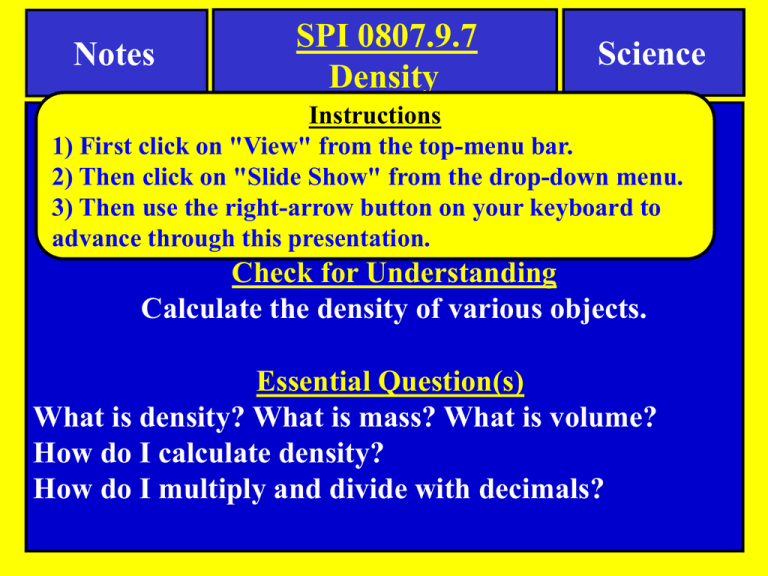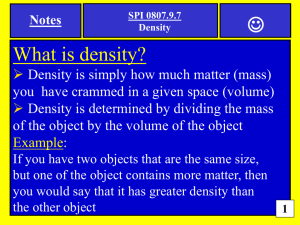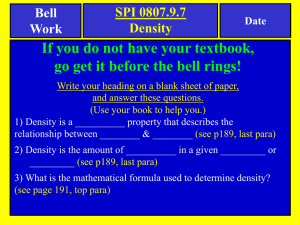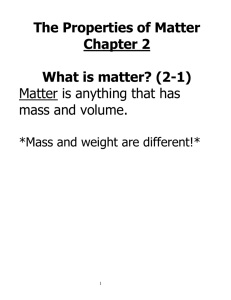(09FEB15) Notes About Density
advertisement

Notes SPI 0807.9.7 Density Science Instructions 1) First click on Tennessee "View" fromSPI the Objective: top-menu bar. an on equation to determine the densitymenu. of an 2) Apply Then click "Slide Show" from the drop-down 3) Then use the right-arrow on and your volume keyboard to object based on button its mass advance through this presentation. Check for Understanding Calculate the density of various objects. Essential Question(s) What is density? What is mass? What is volume? How do I calculate density? How do I multiply and divide with decimals? Humor Silly Thought 20 Never trust an atom. They make up everything. Notes SPI 0807.9.7 Density Science What is density? Density is the amount of matter (mass) you have crammed in a given space (volume) Reminder: mass is how much matter is in an object The unit for mass is grams (mg or g or kg) Reminder: volume is how much space it takes up (size) Unit for solid volume is cubic meters (cm3 or m3 or km3) Unit for liquid volume is liters (mL or L or kL) To compute density - divide the mass by the volume of the object Demonstration: Demonstrate with wadded up paper in a trash can SPI 0807.9.7 Density Notes Science Density Example: Here are two objects that are the same size. (1) Bowling Ball and (2) Soccer Ball One of these objects contains more matter (bowling ball). With two same-sized objects like this, the object with more mass has greater density than the other object. More Dense Less Dense 0807.9.7 Solve The ThreeSPI Density Problems Shown Below Quick Science Go ahead and use a calculator (for now) Density Practice Use this formula: Density=mass divided by volume or D= M Density= volume mass D= M/V or V 1) …density of an object with a mass of 25g a volume of 10cm3? Example: 25 (mass) divided by 10 (volume) Units… Density= 10 25 g/cm3 2) …density of an object with a mass of 45kg a volume of 43m3? Example: 45 (mass) divided by 43 (volume) Units… Density= 43 45 kg/cm3 3) …density of an object with a mass of 350g a volume of 95cm3 ? Example: 350 (mass) divided by 95 (volume) Units… g/cm3 Density= 95 350 Notes Don't Forget Your Units! SPI 0807.9.7 Example: grams/centimeter cubed Density Written like this…g/cm3 Science Density=mass divided by volume Answers 1) …density of an object with a mass of 25g & volume of 10cm3? 25g ÷ 10cm3 = 2.5g/cm3 2) …density of an object with a mass of 45kg & volume of 43m3? (round up to the nearest hundredth) 45kg ÷ 43m3 = 1.05kg/m3 3) …density of an object with a mass of 350g & volume of 95cm3 ? (round up to the nearest hundredth) 350g ÷ 95cm3 = 3.68g/cm3 Notes SPI 0807.9.7 Density Science What is density? Density is the amount of matter (mass) you have crammed in a given space (volume) Density can be… Low, Moderate, or High Low: Cotton Candy Moderate: A brick High: A diamond Demonstration Demonstration in restroom foyer….lets go! Density In Liquids SPI 0807.9.7 Notes Science Lower density liquids will float on top of liquids with higher density Density Example: Oil floats on top of water Designation Substance Density Liquid 01 Water 1.0 g/mL Liquid 02 Liquid Mercury 13.6 g/mL Liquid 03 Turpentine 0.8 g/mL 1) Identify which liquids would occupy levels A, B, and C according to their density. SPI 0807.9.7 (Density) ANSWERS Level A Turpentine (0.8 g/mL) Level B Water (1.0 g/mL) Level C Mercury (13.6 g/mL) Notes SPI 0807.9.7 Density Science Density In Liquids Lower density liquids float on top of liquids with higher density Higher density liquids will sink below lower density liquids View this YouTube Video Clip: Link: 7-Layer Density Column SPI if0807.9.7 Find the density each of these objects Notes Science Again…go ahead and use a calculator (for now) Density (B) (A) Mass: 12g Volume: 3cm3 Mass: 19g Volume: 7cm3 4 g/cm3 2.71 g/cm3 (C) (D) Mass: 11g Volume: 3cm3 Mass: 23g Volume: 5cm3 3.6 g/cm3 4.6 g/cm3 Which cube above has the GREATEST density? SPI if0807.9.7 Find the density each of these objects Notes Science Again…go ahead and use a calculator (for now) Density (B) (A) Mass: 18g Volume: 6cm3 Mass: 29g Volume: 7cm3 3 g/cm3 4.14 g/cm3 (C) (D) Mass: 30g Volume: 8cm3 Mass: 21g Volume: 5cm3 3.75 g/cm3 5.25 g/cm3 Which cube above has the LEAST density?






